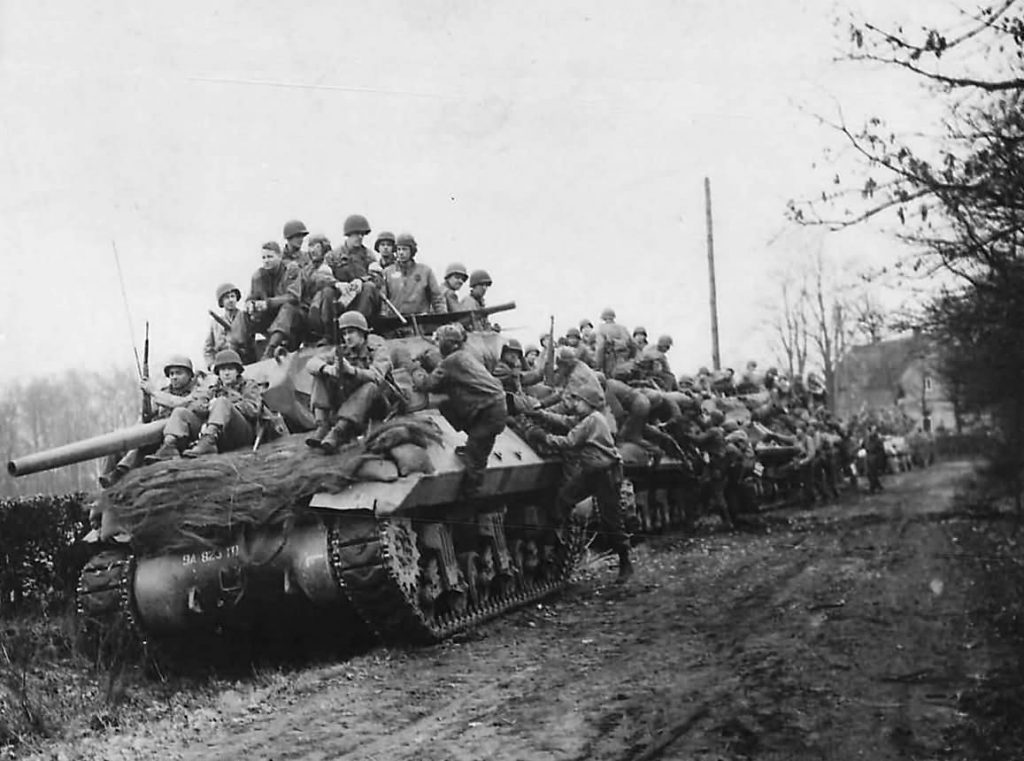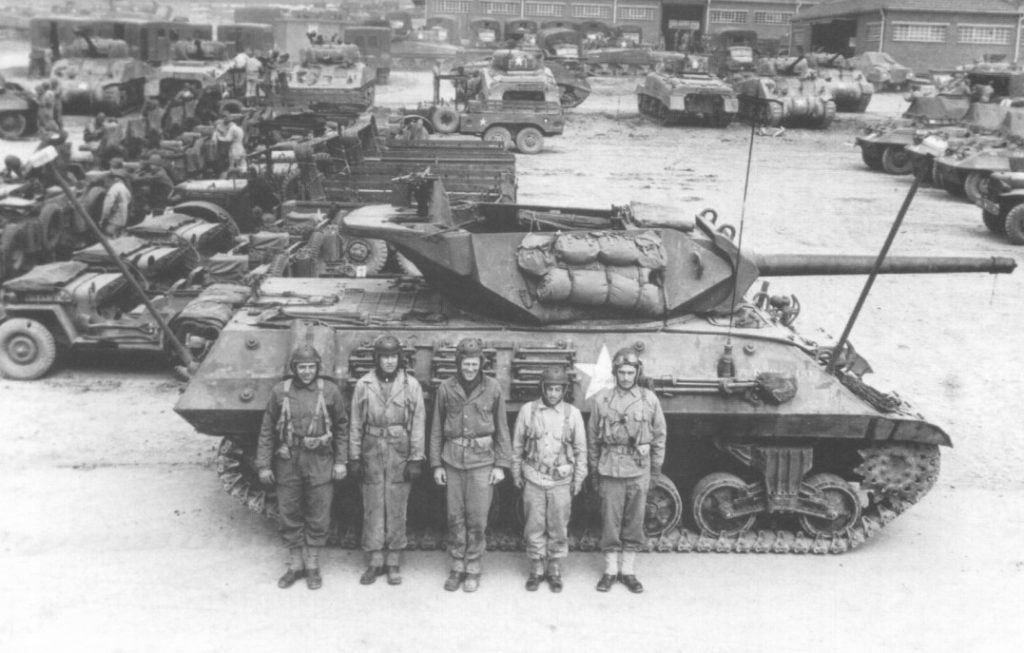M10 “Wolverine” – Unorthodox but packing a Punch

M10 Tank Destroyer or the 3-in. The Gun Motor Carriage M10 is an anti-tank self-propelled artillery (Tank Destroyer) mount of the United States during World War II, a class of tank destroyers, medium class in weight. This combat vehicle in the US Army was abbreviated as the GMC M10 or TD – “tank destroyer”). The American soldiers M10 also had the unofficial nickname “Wolverine”, which they borrowed from their British allies – supplied under Lend-Lease to the UK, the M10 had an official designation of 3-in. SP, Wolverine.
History of creation
Before the start of World War II, the American military command seriously underestimated the role of tanks. In connection with the successful use of tanks during the blitzkrieg in Poland and France, the issue of anti-tank combat became extremely acute for Americans. After a brief debate, General McNair’s point of view prevailed that the fight against enemy tanks should be taken over by specialized anti-tank units, suitably equipped. Such a doctrine was convenient because it did not require changes in the structure, tactics and equipment of existing ground forces. It was assumed that anti-tank units would be transferred to where they were needed and would create a powerful anti-tank defense, preventing tank breakthroughs by the concentration of anti-tank weapons. It was believed that such a technique was more effective against the German strategy of tank spearheads than the traditional anti-tank defense.
In order to provide such a maneuver with anti-tank weapons, it was necessary to equip teams of tank destroyers with equipment appropriate to their tasks, the main requirements for which were powerful weapons that could effectively deal with all types of enemy tanks, as well as high strategic and tactical mobility, allowing you to quickly transfer tanks to threatened areas.
Since the need for tank destroyers was very urgent, the work unfolded in several directions at once. The greatest mobility, cheapness and simplicity was provided by the scheme with a wheeled or half-tracked chassis, implemented in the 37 mm GMC M6 and in the 75 mm GMC M3, but in this case it was not possible to install a sufficiently powerful gun, as well as provide acceptable protection for the crew. Therefore, the requirements for anti-tank self-propelled guns on the chassis of light and medium tanks were formulated.
Work on the creation of a tank destroyer on a medium tank chassis began in December 1941, and the first prototype was the experimental T24 self-propelled gun, which was an M3 anti-aircraft gun mounted in an open cabin on the chassis of an M3 medium tank. After the construction of several test models, including one with the M1918 anti-aircraft gun, the project was closed in April 1942, because it did not meet the requirements of the military in mobility, and, moreover, did not have a rotating turret.
In January 1942, the T35 project was replaced, which the installation of the T12 gun, designed for the M6 heavy tank, on the chassis of the M4A2 medium tank (with light armor), in a circular turret. The gun was mounted in a mount borrowed from the M6, the cast turret was open at the top and rear. In addition, according to the requirements of the military, an alternative version of the T35E1 was developed, which received a new upper hull with sloping armor. The manufactured samples also received a new welded cylindrical turret, which also had sloping armor. The roof of the tower covered only its front part.
Since tests showed the advantage of sloping armor, the T35E1 prototype was recommended for standardization as the M10 tank destroyer. When standardized in June 1942, the M10 received a new pentagonal welded turret. The gun, standardized as the M7, received a new installation of a fundamentally different design.
Production history

Production of the M10 began in September 1942 at the Fisher Tank Arsenal. Two months later, in October 1942, an agreement was signed with Ford Motor Company for the production of a variant on the chassis of the M4A3 tank, which received the army designation M10A1. The reason was the shortage of the M4A2 chassis, which was used to produce the M10.
During production, both variants underwent minor upgrades, related, in particular, to the problem of balancing the initially not very well designed tower. This imbalance made it very difficult to turn the tower, if the vehicles were not on a horizontal surface.
The initial solution was to use track extensions as improvised counterweights. The expanders were hung on the rear wall of the turret on factory mounts, which began to be mounted starting in the autumn of 1942. They also tried to solve the balancing problem by installing a heavy machine gun on the rear of the turret.
After 650 M10s and M10A1s without counterweights were produced, the turrets were fitted with factory-welded counterweights in January 1943. In total, 2850 such self-propelled guns were produced. This was not the final solution to the problem, because the counterweights were found to be too heavy.
As a result, in June 1943, the M10 and M10A1 received a new elongated turret with improved cast counterweights, which were moved further from the center of rotation and lightened. A total of 3200 self-propelled guns with new turrets were produced.
From December 1943, a new design of the gunner’s and commander’s seats was introduced, as well as traverse locks for the gun and turret, and the inconveniently located flywheel of the turret traverse mechanism was also moved. In May 1943, at the request of the army, the self-propelled guns received a set of equipment for firing from closed positions, consisting of an azimuth indicator and an elevation angle of the gun.
Combat use

American warfare doctrine called for the use of tank destroyers to fight enemy tanks, while their own tanks were intended to support infantry in battle. The M10 was the most numerous anti-tank self-propelled gun of the American army in World War II. The vehicle’s debut in North Africa was quite successful, as its three-inch M7 cannon could easily penetrate the armor of most German tanks then available in the North African theater of operations from a long distance without problems. However, the heavy and low-speed chassis did not correspond to the tank destroyer doctrine adopted then in the United States, which required the use of very light and fast vehicles in this capacity. Therefore, at the beginning of 1944, the M10 in parts began to be supplemented by a faster and more lightly armored M18 Hellcat anti-tank self-propelled gun.. During the landings in Normandy, the M10 gun proved ineffective against the frontal armor of numerous German Panther tanks, so in the fall of 1944 it began to be replaced by an improved version of the M36 Jackson anti-tank self-propelled gun. However, the M10s that remained in service continued to be used until the end of the war. In the Pacific theater, the US Army’s M10s were used as conventional close infantry support tanks and were unpopular with crews in this role. The Japanese tactic of dealing with American armor by using infantry with grenades and other anti-tank weapons in extreme close combat made the M10 open on top much more vulnerable than a fully enclosed tank.
M10 Tank Destroyer on the Eastern Front
In particular, the 1223rd Self-Propelled Artillery Regiment, which was part of the 29th Tank Corps, 5th Guards Tank Army, was equipped with these vehicles. This regiment participated in the offensive of the 3rd Belorussian Front near Orsha in June 1944, as well as the 1239th self-propelled artillery regiment of the 16th Tank Corps, 1st Belorussian Front. In particular, Hero of the Soviet Union I. I. Finyutin fought on the M10 as a driver. Also, the famous actor Vladimir Zamansky (“Check on the Roads”) fought on such a vehicle.
Free French units were also equipped with these machines, one M10 called “Sirocco”, operated by French sailors, became famous for knocking out a German “Panther” right on the Place de la Concorde in Paris. In the UK, M10s were designated 3-in. SP, Wolverine and fought in Italy and France. A number of vehicles were re-armed with a much more effective 17-pounder anti-tank gun and received the designation 17-pdr. SP. Achilles.
The open-topped M10 turret made the vehicle vulnerable to artillery and mortar fire, as well as infantry attacks, especially in urban combat and in the woods, when a simple hand grenade could be easily thrown inside the vehicle. By the end of the war, the armor of the M10 had already become insufficient against the new German tank and anti-tank guns. However, the biggest drawback of the M10 was the extremely low turret traverse speed due to the lack of any mechanization of this process. The turret rotated only by hand, and it took about two minutes to make a full turn. In addition, contrary to the written doctrine of use, American tank destroyers used up more high-explosive fragmentation shells than armor-piercing ones, which shows the complete collapse of this doctrine – the vehicles were mainly used as tanks, which they should have supported on paper.
Modifications
- 3-in. Gun Motor Carriage T35 (prototype) – undercarriage from the early M4A2 Sherman medium tanks.
- 3-in. Gun Motor Carriage T35E1 / 3-in. GMC M10 (3-in. SP, Wolverine) – with a diesel engine (about 5000 units).
- 3-in. GMC M10A1 – with a Ford GAA carburetor engine (about 1700 units).
- 17 pdr. SP. Achilles – 3-in. GMC M10, armed with a 17-pounder Mk V gun, the same as on the Sherman Firefly tank and other British vehicles. This variant can be externally identified by a muzzle brake on the gun and a larger counterweight at the rear of the turret.
- Rearmed diesel M10 became 17-pdr. SP. Achilles IC.
- Rearmed carburetor M10A1 steel 17-pdr. SP. Achilles II.C.
- The Full-Track Prime Mover M35 is an M10A1 turretless tractor for towing heavy guns.
Short description
The M10 was based on the chassis of the M4A2 medium tank (the M10A1 modification was based on the M4A3 chassis) with a special turret open at the top, where a 3-inch (76.2 mm) M3 gun was installed. Like tanks, the turret could rotate 360 degrees, which made the self-propelled gun quite effective. To destroy armored targets, an ordinary (caliber, without a ballistic tip, in Western AP terminology) M79 armor-piercing projectile was used, which could penetrate 3 inches (76 mm) of armor at an encounter angle of 30° relative to the normal at a distance of 1000 yards (900 m). The full ammunition load of the gun in the car was 54 rounds. A large counterweight was installed at the rear of the tower, which gave the tower a distinctive and easily recognizable silhouette.
For melee defense and repelling attacks from the air, a 12.7 mm M2 Browning machine gun was installed at the rear of the turret. Machine gun ammunition was 300 rounds. The crew also had their own personal weapons for self-defense.
Armament
| M7 cannon ammunition | ||||||
| projectile type | Brand | Shot mass, kg | Projectile weight, kg | Mass of explosives, g | Muzzle velocity, m/s | Table range, m |
| Armor-piercing shells | ||||||
| armor-piercing with protective and ballistic tips, tracer | APCBC/HE-T M62 Projectile | 12.34 | 6.99 | ? | 793 | 14 600 |
| armor-piercing sub-caliber | APCR-T M93 Shot | 9.41 | 4.26 | — | 1037 | 11 900 |
| armor-piercing continuous, tracer | AP-T M79 Shot | 12.03 | 6.80 | — | 793 | 11 600 |
| High-explosive shells | ||||||
| high-explosive fragmentation | HE-T M42A1 Shell | 11.28 | 5.83 | ? | 854 | 13 400 |
| Smoke projectiles | ||||||
| smoke | HC B1 M88 Shell | 6.98 | 3.34 | ? | 275 | OK. 1800 |
| Armor penetration table for M7 | ||||
| Projectile \ Distance, m | 457 | 914 | 1371 | 1828 |
| meeting angle 30°, homogeneous armor | ||||
| M62 projectile | 93 | 88 | 82 | 75 |
| M93 Shot | 157 | 135 | 116 | 98 |
| M79 Shot | 109 | 92 | 76 | 64 |
| It should be remembered that at different times and in different countries, different methods for determining armor penetration were used. As a result, direct comparison with similar data from other tools is often impossible. | ||||
Interesting Facts

- Post-war American movie star Audie Murphy was awarded the Medal of Honor for displaying valor in combat when he used a stricken and burnt-out M10 machine gun to repulse numerous enemy infantry and did not leave the firing position, despite several hits in the hull of this self-propelled gun.
- During the preparation of the Ardennes operation, several Panthers of the 150th Tank Brigade, whose purpose was to carry out combat and sabotage operations behind Allied lines, were disguised as the M10 wolverine. On February 21, 1945, the camouflaged Panthers met with units of the 120th US Infantry Regiment. One car was destroyed, three were abandoned by the crews and fell into the hands of the Americans.
- As part of the crew of one of the M10 delivered to the Soviet Union under Lend-Lease, the actor Vladimir Zamansky fought. In June 1944, as a radio operator of the 1223rd Self-Propelled Artillery Regiment, which was part of the 29th Tank Corps, 5th Guards Tank Army, Zamansky participated in the offensive of the 3rd Belorussian Front near Orsha. During the fighting, Zamansky’s car was hit and caught fire. Despite a severe head wound, Zamansky saved a wounded commander from a burning self-propelled gun. On February 2, 1945, Zamansky’s self-propelled gun destroyed 50 German soldiers in battle, knocked out an enemy T-IV tank, two carts with ammunition, after which the vehicle’s crew captured and held an important crossroads.
- M10, operated by French sailors, destroyed the Panther on the Place de la Concorde in Paris.






